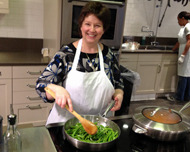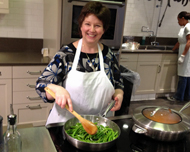How Julia Child Changed The Way We Cook
Julia Child may have taught America how to perfectly roast a chicken, make boeuf bourguignon, and tell a paring knife from a chef's knife, but her effect on the state of American home cooking is much broader than that.
We spoke with Stephanie Hersh, Child's personal assistant for nearly 16 years, who is currently hosting classes at Sur La Table's cooking schools in honor of Julia Child's birthday, to get her perspective on Child's impact on kitchens across America.
But first, you may be wondering: How exactly does someone land a job like that? Hersh, who moved to New Zealand eight years ago following Child's passing, says that it was just a matter of "being in the right place at the right time." It sounds totally cliché, but in this case, it's true.
Hersh, upon graduating from the Culinary Institute of America in Hyde Park, N.Y., moved to Boston seeking a quiet, corporate job while she figured out what she wanted to do. She enrolled in a three-month-long secretarial program at Katherine Gibbs, a now defunct vocational school, in order to brush up on her typing skills. The day she was about to take her final typing exam, she was in the placement office when the assistant called for her, saying that Julia Child was on the phone and that Child was looking for a secretary with a culinary background. Did she want the job?
"Of course!" was Hersh's enthusiastic reply (who, in their right mind, would say anything else?) and the rest, as they say, is history. But when Hersh first got on board, she didn't do any cooking. That's because Child really was looking for a secretary to help run the office, which had gotten a bit out of hand.
It was 1961, and Mastering the Art of French Cooking had just been published. Hersh notes in hindsight that the initial response to the seminal cookbook was lukewarm, but a friend of Child had offered to help the cause by featuring Child and her cookbook in a live television show called I've Been Reading. Child accepted the offer, but put her unique spin on things.
Rather than go on about her book like previous guests, Child decided to do a little show and tell — she brought some eggs, a bowl, and a whisk, and performed a little cooking demonstration. The show's producers were so impressed that they decided to give Child a pilot of 13 shows, which she and her husband Paul titled The French Chef.
Photo courtesy of Sur La Table)
Hersh soon transitioned from working part-time to working full-time with Child, and they even started going to the movies together. Child dubbed Hersh her "Executive Personal Assistant," inspired by the ending credits to a Meryl Streep (how ironic) movie in which someone was named said title. As the years progressed, Hersh began assisting Child with cooking demonstrations and traveling with her, so she got to know Child on a fairly personal level. So what was it like working for Child? "It was sort of like working for your idol and your mentor and your grandmother all wrapped up into one," says Hersh.
That explains why Child was able to so deftly demystify complicated French cooking techniques for the layman cook at home. Child's greatest impact on American home cooking was her ability to make people realize that cooking should be fun. It was OK to make mistakes in the kitchen (Child, after all, didn't really learn how to cook herself until she was in her 40s) and of course, learn from them.
Speaking of mistakes, that reminds us: Did Child really drop that chicken on the floor?
Hersh says that never happened. (Sorry to burst your bubbles.) What actually happened was a little hiccup with a potato galette. In her attempt to flip it, the galette landed on the burner. This was on live television, mind you. Unruffled, Child moved on in her ebullient manner and proceeded as if nothing had gone wrong. It was this easy, approachable manner that made Child appeal even to everyone; even people who didn't like to cook would watch her shows, says Hersh.
Equally important was Child's constant emphasis on using fresh ingredients. At a time when the paradigm in the kitchen was shifting away from actual cooking (sound familiar, anyone?), and convenience mattered more than flavor or presentation, Child was introducing the American cook to what were then novel ingredients — for example, white button mushrooms and artichokes, now available nearly year-round in supermarkets, were things that required a trip to a specialty shop in the post-World War II era. The technologies of the war were being turned toward the purposes of food production — weapons into pesticide and fertilizer, and rations into processed convenience foods such as TV dinners, boxed mixes, and powdered milk and eggs, fed to a population that was growing quickly accustomed to them.
Child, however, capitalized on the countermovement. She saw that in the wake of the war, the cost of traveling had decreased, allowing people to travel to France, Europe, and other "exotic" regions beyond, and they came back enamored with the cultures they had encountered. They were willing to try new things.
But who could make new things like complex French cuisine accessible? That's where Child came in. Hersh says that Child opened people's eyes to the fact that there was a variety of food, encouraged them to try new recipes, to take food and food preparation seriously again, but at the same time, to have fun.
So it may be more accurate to say that Child rescued home cooking instead of transforming it. And in light of some rather unsettling statistics on the state of cooking today (on average, Americans today spend only about 30 minutes a day cooking, if they cook at all), perhaps it's time another Julia Child came along to remind us just how important it is to cook — really cook, not just open up a can of soup, heat it up, and call it a meal. So, if you really want to honor Child's legacy, the simplest thing you can do is to get in the kitchen, and just cook something.
Will Budiaman is the Recipe Editor at The Daily Meal. Follow him on Twitter @WillBudiaman.

